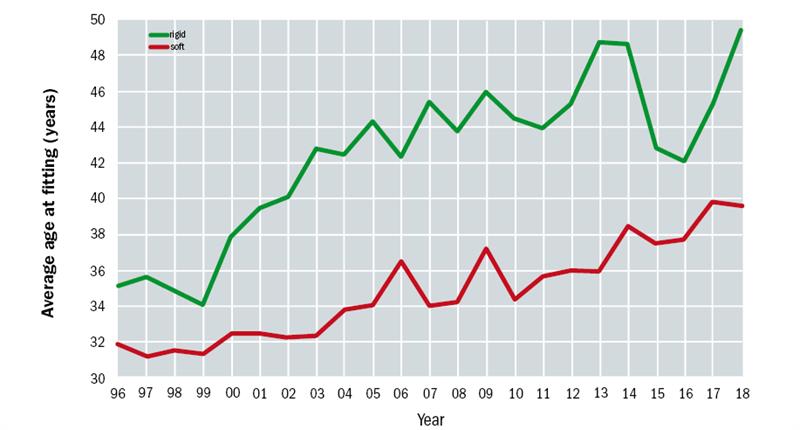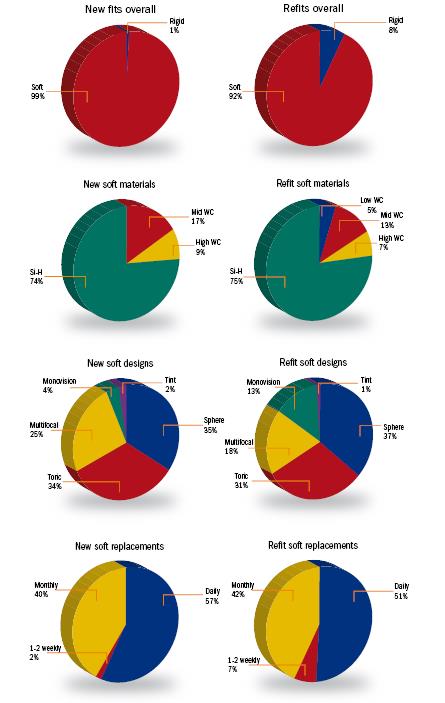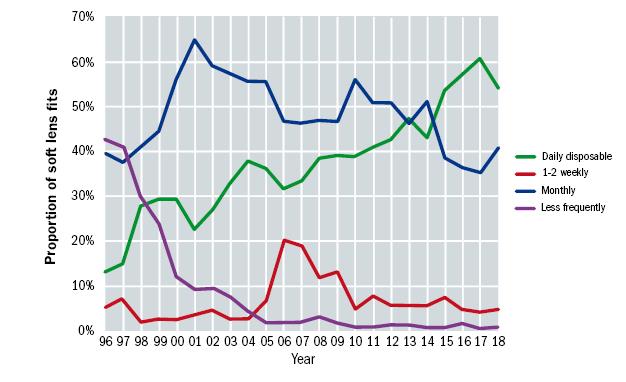To inform practitioners, researchers and industry alike, we have reported on the contact lens fitting behaviours of British optometrists and opticians since 1996.1-22 This has allowed us to capture the impact of daily disposable soft lenses, the success of silicone hydrogels and increases in the use of soft toric and multifocal lenses, amongst other trends.
After starting the work in the UK, other colleagues from around the world expressed an interest in collecting similar information for their markets to the point where The International Contact Lens Prescribing Survey Consortium has now gathered information about contact lens prescribing patterns in 62 countries. The results from this endeavour are published in national and international trade and academic journals. The annual survey seeks to collect generic, prospective information about 10 lens fits conducted after receipt of the survey form which is sent out at the start of each calendar year.
In 2018, we wrote to 1,400 optometrists and 600 contact lens opticians, randomly selected from the GOC register. Our form requests background information about each practitioner (such as time since registration and type of practice) and then specifics for 10 contact lens fits:
- Date of fitting
- New fit or refit
- Age and sex of patient
- Lens material
- Lens design
- Frequency of replacement
- Days per week of wear
- Modality (daily or extended wear)
- Care system
A weighting system is employed to account for the volume of activity undertaken by the respondents, calculated by the time period required to achieve 10 fits.
For 2018, we received data from 72 contact lens opticians, 50 optometrists and two ‘not recorded’ practitioners. This group provided information about 1,176 contact lens fits. The mean age at fitting was 40.1 ± 17 years (mean ± standard deviation).
This is the second consecutive year where the average age at fitting has been greater than 40 years. This metric has increased steadily over the course of this project (Figure 1).

Figure 1: Average age of fitting for rigid and soft lenses
Soft lens wearers were about 32 years old on average at fitting in 1996, increasing to 40 years old today. Rigid lens wearers are typically older than their soft lens counterparts at fitting; this group was in their mid 30s in 1996 and are close to 50 years old, on average, in 2018.
This ageing of the contact lens fitting population probably reflects two phenomena. First, an increasing cohort of wearers wish to continue wearing contact lenses for many years (attending for successive fitting visits).
Secondly, improved multifocal lens design offers a better options to older, presbyopic patients; there is likely to be overlap for these two explanations.
In 2018, the range of patients at fitting was from six to 86 years. Sixty five per cent of those fitted were women and 73% were prescribed with lenses for full time (four days per week) wear. The ratio of ‘new fits’ and ‘refits’ was exactly 50:50.
Rigid versus soft lens fits
Soft lenses were prescribed to 99% of new fits and 8% of refits (Figure 2), indicating that the recent dominance of soft contact lenses in continuing in the UK.

Figure 2: New fit and refit trends
Soft lens details
Three quarters of all soft lenses prescribed are silicone hydrogels with the remaining lenses principally mid and high water conventional hydrogels.Toric lenses (in at least one eye of the pair) are prescribed in about one third of cases.
If multifocal, monovision and cosmetically tinted lenses are excluded, then 48% of soft lens fits include a toric lens to at least one eye, indicative of very wide scale adoption of this lens type.
Multifocals account for 25% of new fits and 18% of lens fits – close to a ten-fold rise compared to the market in the late 1990s.
Eight soft lens fits were recorded for myopia control in 2018 – this is a useful benchmark figure for future years as there appears to be increasing interest in this form of contact lens correction.
Daily disposable lenses accounted for more than half of soft lens fits – this is the fourth consecutive year where this has been the most widely prescribed replacement interval (Figure 3).

Figure 3: Replacement intervals for soft lens types
Multipurpose solutions were prescribed for 94% of lens fits.
Rigid lens details
We received information about a relatively small number of rigid lens fits so caution needs to be applied when considering the breakdown of these lenses into the various sub-categories.
However, simple spherical rigid lenses accounted for a minority of fits in 2018 with significant proportions of lens fits from toric, multifocal and orthokeratology designs.
Philip Morgan is professor of Optometry and director of Eurolens Research at The University of Manchester.
References
1 Morgan PB. The trends in UK contact lens prescribing 2017. Optician 2017; 252 (6626): 12-14.
2 Morgan PB. The trends in UK contact lens prescribing 2016. Optician 2016; 252 (6573): 14-15.
3 Morgan PB. Trends in UK contact lens prescribing 2015. Optician 2015; 250 (6518): 12-13.
4 Morgan PB. Trends in UK contact lens prescribing 2014. Optician 2014; 248 (6468): 28-29.
5 Morgan PB. Trends in UK contact lens prescribing 2013. Optician 2013; 246 (6418): 16-17.
6 Morgan PB. Trends in UK contact lens prescribing 2012. Optician 2012; 244 (6364): 14-15..
7 Morgan PB. Trends in UK contact lens prescribing 2011. Optician 2011; 242 (6313): 14-15.
8 Morgan PB. Trends in UK contact lens prescribing 2010. Optician 2010; 239 (6255): 34-35.
9 Morgan PB. Trends in UK contact lens prescribing 2009. Optician 2009; 238 (6205): 20-21.
10 Morgan PB. Trends in UK contact lens prescribing 2008. Optician 2008; 235(6154): 18-19.
11 Morgan PB. Trends in UK contact lens prescribing 2007. Optician 2007; 233(6104): 16-17.
12 Morgan PB. Trends in UK contact lens prescribing 2006. Optician 2006; 231(6054): 16-17.
13 Morgan PB, Efron N. Trends in UK contact lens prescribing 2005. Optician 2005; 229(6004): 28-29.
14 Morgan PB and Efron N. Trends in UK contact lens prescribing 2004. Optician 2004; 227(5950): 16-17.
15 Morgan PB, Efron N. Trends in UK contact lens prescribing 2003. Optician 2003; 225 (5904): 34-35.
16 Morgan PB, Efron N. Trends in UK contact lens prescribing 2002. Optician 2002; 223 (5849): 28-30.
17 Morgan PB and Efron N. Trends in UK contact lens prescribing 2001. Optician 2002; 221 (5803): 38-39.
18 Morgan PB and Efron N. Trends in UK contact lens prescribing 2000. Optician 2000; 219 (5749): 22-23.
19 Morgan PB and Efron N. Trends in UK contact lens prescribing 1999. Optician 1999; 217 (5700): 43-44.
20 Morgan PB and Efron N. Trends in UK contact lens prescribing 1998 Optician 1998; 216 (5679): 18-19.
21 Morgan PB and Efron N. Trends in UK contact lens prescribing 1997. Optician 1997; 214 (5630): 32-33.
